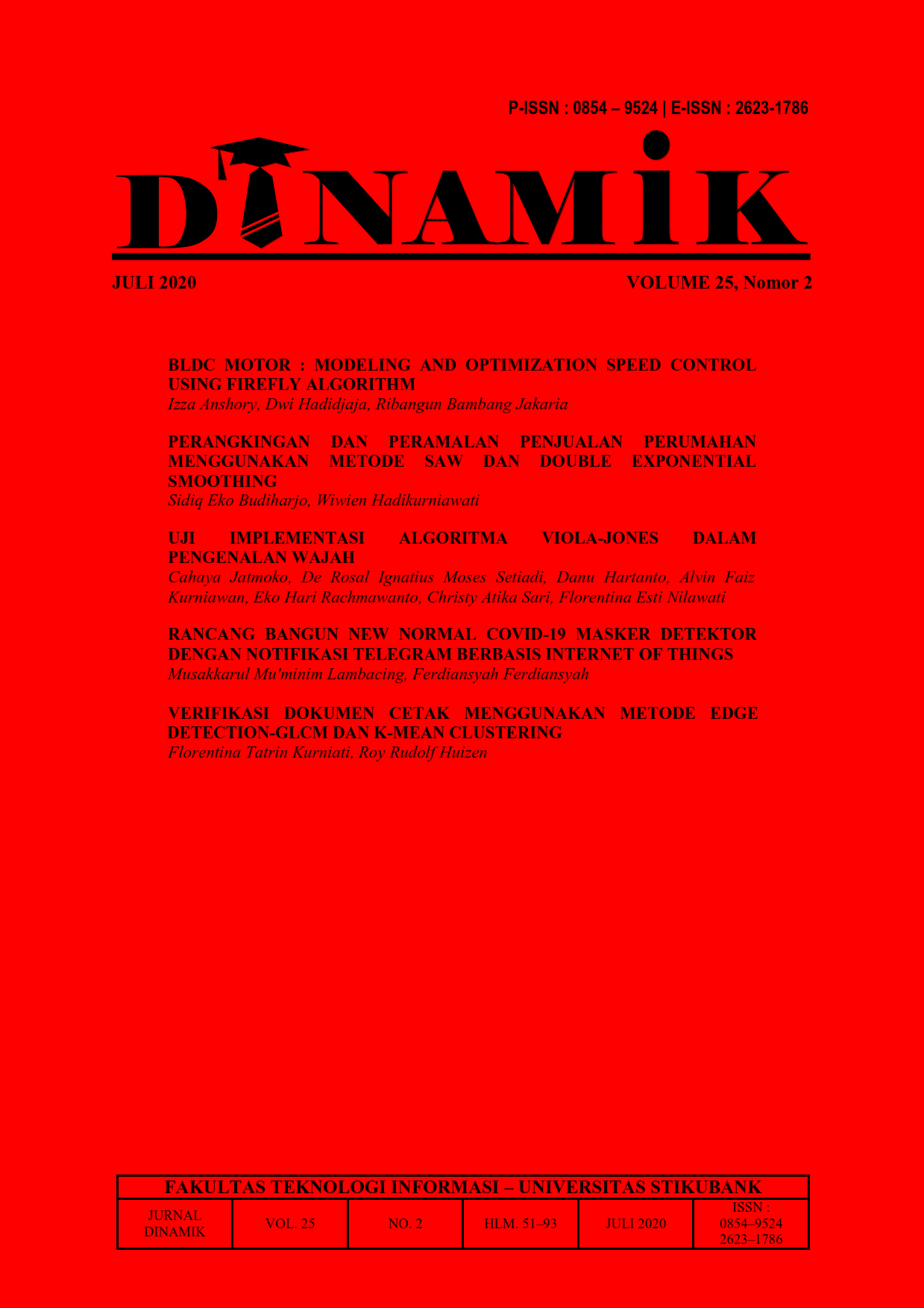VERIFIKASI DOKUMEN CETAK MENGGUNAKAN METODE EDGE DETECTION-GLCM DAN K-MEAN CLUSTERING
Abstract
Dokumen cetak merupakan data digital yang tervisualisasi di kertas. Dokumen cetak mudah dibuat sekaligus dipalsukan. Cara mengetahui keasliannya dengan verifikasi ciri. Setiap dokumen cetak terdapat ciri unik berasal dari printer yang digunakan. Mengembangkan metode untuk menentukan keaslian dokumen cetak dari printer jenis dan tipe sama menjadi tantangan untuk diselesaikan pada penelitian ini. Proses verifikasi menggunakan tahapan akuisisi, ekstraksi, pengenalan pola dan hasil verifikasi. Data uji menggunakan 6 printer jenis dan tipe sama, masing-masing menggunakan 3 lembar sampel, untuk karakter dipilih 8. Hasilnya pengujian menunjukkan nilai EER (equal error rate) sebesar 0,18 dari nilai tersebut digunakan menentukan nilai ambang verifikasi yaitu 80% dari nilai kedekatan. Verifikasi dengan kedekatan diatas 80% berarti dokumen cetak dinyatakan asli (accepted) sedangkan kedekatan dibawah 80% berarti dokumen cetak dinyatakan palsu (rejected). Pengujian menggunakan 20 varian dokumen cetak diperoleh nilai kedekatan tertinggi 97,7% dan terendah 84,1%. Berdasarkan pengujian diperoleh suatu kesimpulan bahwa meskipun pemalsuan menggunakan printer dengan jenis dan tipe yang sama, model mampu memilah dan menentukan suatu dokumen cetak asli ataupun palsu.
References
[2] R. Shao and E. J. Delp., 2020 “Forensic Scanner Identification Using Machine Learning” ,vol. 2020-March, pp. 1–4, Proc. IEEE Southwest Symp. Image Anal. Interpret.
[3] Y. Wu, X. Kong, X. You, and Y., Guo, 2009 “Printer forensics based on page document’s geometric distortion,” pp. 2909–2912, International Conference on Image Processing (ICIP).
[4] M. Tsai and J. Liu.,2013, “Digital Forensics for Printed Source Identification,” pp. 2347–2350, International Symposium on Circuits and Systems (ISCAS)
[5] S. Elkasrawi and F. Shafait., 2014 “Printer Identification using Supervised Learning for Document Forgery Detection,” International Workshop on Document Analysis Systems.
[6] F. T. Kurniati, A. J. Santoso, and Suyoto., 2015, “Printer Forensik Untuk Identifikasi Dokumen Cetak,” pp. 6–8, Semin. Nas. Teknol. Inf. dan Multimed.
[7] M. Bibi, A. Hamid, M. Moetesum, and I. Siddiqi., 2019, “Document Forgery Detection using Printer Source Identification—A Text-Independent Approach,” pp. 7–12. International Conference on Document Analysis and Recognition Workshops (ICDARW)
[8] O. Mayer and M. C. Stamm., 2020, “Forensic Similarity for Digital Images” , vol. 15, pp. 1331–1346, IEEE Trans. Inf. Forensics Secur.
[9] A. C. Valente et al., 2020, “Print defect mapping with semantic segmentation,” pp. 3540–3548, Winter Conference on Applications of Computer Vision (WACV).
[10] F. T. Kurniati and R. R. Huizen., 2017, “Anomali Fitur Dokumen Cetak Untuk Verifikasi Di Printer Forensik,” pp. 820–825, Konferensi Nasional Sistem & Informatika.
[11] J. S. Owotogbe, T. S. Ibiyemi, and B. A. Adu., 2019, “Edge Detection Techniques on Digital Images - A Review”, vol. 4, no. 11, pp. 329–332, Int. J. Innov. Sci. Res. Technol. International Journal of Advanced Engineering Research and Science (IJAERS)
[12] A. Hamid, M. Bibi, I. Siddiqi, and M. Moetesum, “Historical manuscript dating using textural measures,” Proc. - 2018 Int. Conf. Front. Inf. Technol. FIT 2018, pp. 235–240, 2019.
[13] R. Ghosh, C. Panda, and P. Kumar., 2018, “Handwritten Text Recognition in Bank Cheques,” Conf. Inf. Commun. Technol. CICT .
[14] T. Gupta and S. P. Panda., 2019, “Clustering Validation of CLARA and K-Means Using Silhouette DUNN Measures on Iris Dataset”, pp. 10–13, Proc. Int. Conf. Mach. Learn. Big Data, Cloud Parallel Comput. Trends, Prespectives Prospect. Com.
[15] N. Sapkota, A. Alsadoon, P. W. C. Prasad, A. Elchouemi, and A. K. Singh., 2019, “Data Summarization Using Clustering and Classification: Spectral Clustering Combined with k-Means Using NFPH”, pp. 146–151Proc. Int. Conf. Mach. Learn. Big Data, Cloud Parallel Comput. Trends, Prespectives Prospect. Com.
[16] J. X. Zhao and M. Y. Liu., 2008 “A color HSV image edge detection method based on gradient extreme value,” vol. 3, pp. 381–384, Int. Symp. Intell. Inf. Technol. Appl.
[17] Y. Y. Zheng, J. L. Rao, and L. Wu., 2010 “Edge detection methods in digital image processing,” pp. 471–473, ICCSE - 5th Int. Conf. Comput. Sci. Educ.









